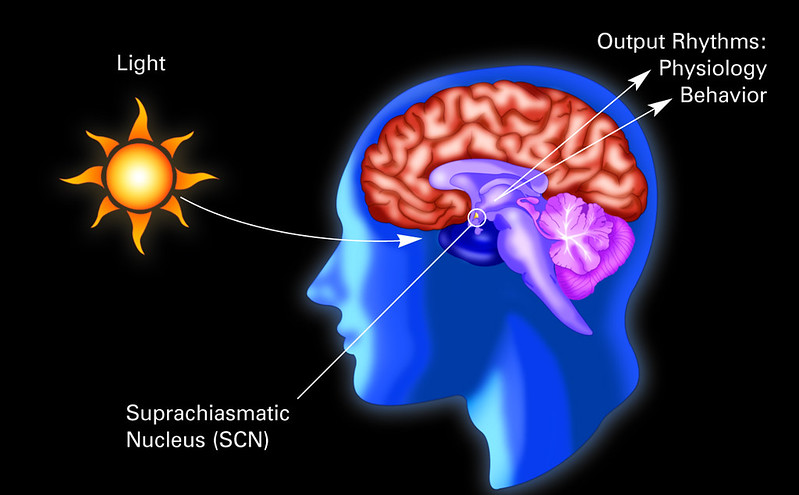
Guest Writer HOW IT WORKS
brains circadian hormones neuroscience research
How does your clock tick?
by Mythreayi Shan, runner-up of the 2020 TLS Writing Contest.
It’s late at night. You start to feel tired, so you set your alarm for the next day and go to bed. When you wake up, you notice that it’s still dark outside so you check the time to see if you’ve woken up too early, and you realize you’ve actually slept until the next night! But you don’t feel tired when you wake up, if anything you feel a little hungry. So you decide to eat and go on the internet for a while until you finally begin to feel tired and fall asleep just as the sun rises the following day. What if this cycle of staying awake during the night and sleeping during the day were to continue for some time?

Figure 1: Imagine a scenario in which your sleeping patterns were drastically altered, Source Petr Kratochvil [1].
Now at this point you may be thinking that this seems too ridiculous, but this was an actual experiment performed on a group of individuals… just not humans. This was a study done by my research mentor, Stephanie Padilla of the University of Massachusetts Amherst, who manipulated a population of neurons called the KNDy neurons in the brains of mice. This manipulation resulted in a disruption in their circadian rhythms [2].
Circadian rhythms are 24-hour cycles generated by a “master clock” in your body that determines when you should be performing certain biological processes during the day. Some processes include what time you should be awake, as well as what time you should sleep, eat, and so on (3). These circadian rhythms are found in most living organisms. In mammals, the clock is controlled by neurons in a region of the brain called the suprachiasmatic nucleus (SCN).
It is important for our bodies to sleep when it is dark. When we travel to different time zones, SCN neurons need to make adjustments to set our sleeping patterns to the new time of night. This is possible because the clock neurons receive light information from light-sensing cells in the retina and can synchronize to new time zones.
Your sleeping patterns can also be influenced by steroid hormones, such as estrogen and progesterone in females. However, the mechanism behind regulation can start to get complicated as the master clock neurons in the SCN lack the receptors necessary to detect the presence of estrogen. So how do estrogen levels influence the female body’s circadian rhythms?

Figure 2: Circadian rhythms are controlled by a master clock located in the SCN, Source NIGMS [4].
We hypothesize that a nearby population of cells, the aforementioned KNDy neurons, serve as a “middle-man” in this interaction – similar to the light-sensing retinal cells. KNDy neurons are both sensitive to estrogen and can influence circadian behaviors, although it is unclear if these neurons communicate directly with the master clock. In order to test our hypothesis, we are using fluorescent markers to highlight the presence of postsynaptic KNDy neurons (the KNDy neurons that receive neurotransmitters) in and around the master clock neurons in sections of female mouse brains. With the fluorescent markers, we can visualize the presence of RNA transcripts of KNDy neurons in a separate region near the SCN that would infer communication between the two.
The scenario at the beginning of this article is a real, albeit exaggerated, possibility. Your circadian rhythms really can shift when your body goes through drastic changes in sex hormone levels for both men and women, and this can lead to loss of sleep and irregular eating habits. These symptoms are common for people going through puberty, pregnancy, menstrual cycle, and menopause. Not to mention, defects in KNDy neurons have shown to lead to several reproductive disorders, such as ovarian syndrome and hypogonadism. So, if we can advance the discovery of the exact mechanisms in the brain that allows sex hormone levels to influence your circadian rhythms, then we will be able to further aid the process of finding treatments for these symptoms and disorders.
References:
Tiwari, Anuj. “Sleeping Less Than Six Hours Is Linked To The Onset Of Cardiovascular Diseases.” Indiatimes.com, India Times, 29 Aug. 2018,
Padilla SL, Perez JG, Ben-Hamo M, Johnson CW, Sanchez REA, Bussi IL, Palmiter RD, de la Iglesia HO. 2019 Curr Biol. Feb 18;29(4):592-604.
Hastings MH, Maywood ES, Brancaccio M. 2018 Nature Reviews Neurosci. Volume 19, pages453–469.
Buttgereit, Frank, et al. “Clocking in: Chronobiology in Rheumatoid Arthritis.” Nature News, Nature Publishing Group, 24 Mar. 2015, www.nature.com/articles/nrrheum.2015.31?draft=collection.
More From Thats Life [Science]
- CRISPR technology may be a promising tool to combat multidrug resistant fungus C. auris
- How the search for a universal gene forever changed biology: the story of Carl Woese and 16S sequencing
- Quarantine Blues? The Effects of Social Isolation in the Brain
- The Lovebug Effect
- CRISPR: Careful When Running with Genetic Scissors
- More ›
